Latest News
December 3, 2007
By Al Dean
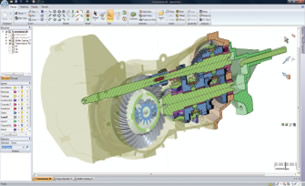 The new Cross Section tools allow you to strip back a part or assembly, present the internal forms of the geometry in an understandable and standard manner, and then use the edge pull command to directly manipulate that geometry.For those working with products with complex forms (pumps, drive, or powertrain components as well as medical devices), this makes a huge amount of sense. |
SpaceClaim — founded a little more than two years ago by Mike Payne and a handful of industry luminaries — just might be the next big thing. Payne, who was the founding architect of Pro/ENGINEER (a system that brought about the parametric design revolution that remains the bedrock of today’s 3D modeling systems), and what became SolidWorks, is largely responsible for kickstarting the Windows-based modeling revolution that we consider mainstream today.
There’s a common thread running through these milestones, a thread of three core technologies. First, there’s the feature-based modeling methodology where geometry construction is split into explicit operations. Second, there’s history, commonly represented as a hierarchical tree of features created in steps to arrive at an end result (if features are the ingredients, then history is the recipe). Third, you have parametrics, the glue that connects individual entities within a sketch, each feature, between parts, and so on. But herein lies the problem.
As features, history, and parametrics are highly interdependent, the editing of parameters and feature variables can cause utter havoc in your part and assembly models — and the earlier they occur in the history, the more problematic they become. So, if Pro/E brought about this state of affairs, SolidWorks took it to the Windows platform and changed the pricing landscape and everyone else followed. So where do we go next? One answer is the doorstep of Mike Payne and SpaceClaim Corporation, and the SpaceClaim Professional 2007 application.
The first release of the solution appeared in June of this year and as we were going to press with this issue, the next version (SpaceClaim 2007+) was being trotted out for pre-release evaluations. What this means is that we have to get up to speed quickly, so let’s crack on.
User Interface
A UI is something that affects everyone. If it’s good, you don’t notice; if it’s bad, it gets in the way. In the case of SpaceClaim, the user experience illustrates its youth. Rather than carry forward baggage associated with previous Windows and Office releases, SpaceClaim adopts the tab- and ribbon-driven toolbar approach anyone using Office 2008 will be familiar with. In terms of SpaceClaim’s command sets, these are currently split into three groups: Design, Detailing, and Display. Display is pretty self-explanatory. It gives you access to the display options for the data you’re viewing — such as shading method, hidden line removal, etc. It also allows you to control layers, grid display, window controls, and so on. Now, let’s get down to the fun stuff.
Features without history
SpaceClaim differs from the likes of Pro/E, SolidWorks, Solid Edge, CATIA, and Inventor. As discussed, most systems use history, features, and parametrics. The features provide the ingredients, the history tree provides the recipe or order in which they’re built to create the geometry, and parametrics create the intelligence that drives design change. SpaceClaim has no concept of history, just features, but these are not discretely stored operations. By using an inference engine, SpaceClaim allows you to select and edit features directly, when you choose, and it just works.
Modeling basics
To create a model, you start with a sketch and have access to all of the 2D sketching entities and editing tools you’d expect: lines, circles, arcs, splines, trim, fillet offset, etc. You create a profile and then do something with it. This is where you come across another differentiator for SpaceClaim. Rather than an array of modeling operations for extrudes, cuts, revolves, etc., you have just two operations — Pull and Move. Pull is used to create geometry while Move is used to edit — simple as that. When using Pull, geometry created will depend on the sketch you’ve created. Dimensional values can be created to fix operation limits, or other geometry can be ‘touched’ to create a relationship. What’s key is the fluidity of the workflow.
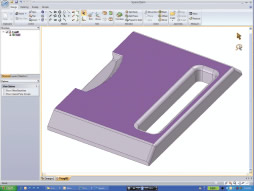 Looking at the modification tools, let’s start with a basic tray component from a BBQ (don’t ask).The form is unappealing and, in today’s designconscious world, is unacceptable. Let’s use SpaceClaim to spruce thingsup a little. | 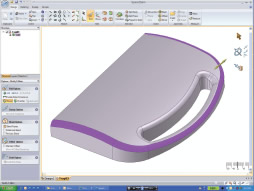 The bend and edit in Cross Section tools are used to edit the cross section of the tray to provide more fluid forms. Features edited and design intent (such as the parallel or offset nature of the handle form) are maintainedthrough some pretty radical design changes. |
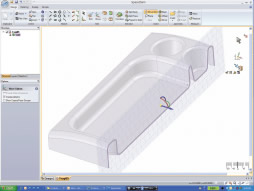 By invoking the cross-section command, you’re presented with a planarcut through the part (which can be moved). | 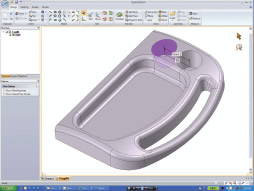 The planar cut allows you to edit that cross section. Finally, some holdersare added for your choice of tasty, BBQ-operating beverage. |
The fact that there’s a single operation for geometry creation masks the fact that you can create much more than simple extrusions. Depending on your selections, the same command will also create lofts, fillets, and chamfers. For example, by selecting an edge and pulling the arrow placed on the edge, you immediately create a fillet. More edges are added by manual selection or by tangency selection. If you want to add a fillet to every feature edge (boss or pocket), you can select that feature using the filters located on the right hand side of the UI. And these filters (or Power Select tools) are pretty nifty, allowing you to identify common features, such as pockets, bosses, and such. You can find common features — such as holes with the same diameter — and make rapid edits to multiple features.
Other features worthy of note are the editing tools. They center on the use of cross sections to edit geometry. By invoking the cross-section command, you’re presented with a planar cut through the part (which can be moved) and this allows you to edit that cross section. Unlike other systems that require the user to edit the explicit sketch on which a feature is based, SpaceClaim lets you dynamically generate and manipulate any cross section, anywhere on the model. Straight edges can be converted (or bent) into arcs, geometry can be directly dragged and dropped, or a dimensional relationship created. What’s amazing is that the whole process, like so much else within the system, is fluid and unrestrained. It’s very easy to take a basic shape or form and edit it with the use of the Bend tool, modify cross sections by direct interaction, and turn it into a very slick form in a matter of seconds.
The 2007+ release extends these tools with some new capabilities like the ability to work in 3D section view. This lets you trim back a part or assembly and dynamically work with the section view, allowing you to manipulate the internal geometry. Users can edit a feature by simply pulling edges (rather than using the cross-section method) to create or modify forms. By selecting and dragging edges, adjacent faces will adapt to that change where appropriate.
The 2007+ version also adds a Sheet Metal module, enabling the creation of sheet metal forms from scratch as well as the ability to load sheet metal components from other systems and edit them. Bend reliefs are automatically created or maintained and you can work in both 3D and flat pattern simultaneously. The system doesn’t yet include the more advanced sheet metal capabilities such as punch forms, but that’ll come with time.
Of course, for all the talk of geometry modeling from scratch, one of the key unique selling points for SpaceClaim is the previously unheard-of levels of native data support. This is the first time that a single system has been able to import geometry directly from such a wide range of native data formats. SpaceClaim has agreements with the many MCAD vendors, allowing them to read and, just as importantly, write data in native format. Alongside the usual STEP, VDA, and IGES formats, SpaceClaim also offers direct read/write capabilities for Pro/E (.prt and .asm), SolidWorks (.sldprt and .sldasm), Inventor (.ipt), CATIA version 4 and CATIA V5 (.CATPart and .CATProduct — and will maintain any PMI or 3D annotation stored within those files), NX (.prt), AutoCAD (.dwg, .dxf), Parasolid (.x_t and .x_b), and ACIS (.sat and .sab) files. The 2007+ release can also read and write JT data. You can also open Rhino models directly, create and modify any solid geometry, then pass that data back to Rhino for surface modifications.
SpaceClaim has achieved this is by using licensed libraries rather than via a third party or reverse engineering. This means that data translation isn’t an issue. The modeling tools all work with these data files — essentially, the source of your data doesn’t matter, whether it’s built from scratch within SpaceClaim, imported by STEP, or read directly from CATIA V5 or Pro/E — the same tools and capabilities apply. This means that SpaceClaim is perfect for downstream use of 3D, and for those working in a supply chain, and users can write the data back out in those same formats.
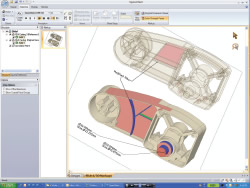 The Part Comparison tools allow you to fully define Design change, dimensions can be shown with old and new values, and everything isstored within the same datafile as the model. | 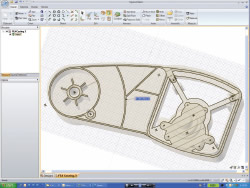 Cross Section based editing is key to SpaceClaim’s capabilities — the ability to directly manipulate geometry in the model,wherever you need to, ratherthan having to edit a specific sketch, is a powerful tool for design iteration. |
Parametrics
The 2007+ release presents a very interesting addition — parametrics in the traditional sense. Well, sort of. What has been added is the ability to create Named Dimensions. These are intended for use when you want to create a dimension that’s used to drive design change and needs to be accessible. You create the Named Dimension and it’s available from a list to modify. What’s interesting is that this variable doesn’t need to be a formalized part of a sketch or feature limit. It’ll also be available to third parties as it will be exposed in the API as things move forward, so FEA tools can drive design optimization directly within SpaceClaim.
Assemblies
SpaceClaim works in a single file manner, meaning that everything you create — be it parts, assemblies, and subassemblies — is contained within a single data file. Parts contain multiple solid bodies, surfaces, etc. The structure browser is used to define how those parts and solids are assigned, and it’s easy to swap between them. Solids can be combined using Boolean operations to join, split, and cut geometry. When you need to constrain parts, these can be aligned by plane or by concentric centers as you’d expect, using a small set of commands. SpaceClaim doesn’t yet have the ability to dynamically manipulate that assembly (such as simulating a moving mechanism), but it does include a Lightweight Assemblies mode, which allows fast loading of large assemblies.
Detailing
The Detailing tools within SpaceClaim serve two functions. The first is the ability to create drawing views of your part or assembly, then add the annotations, dimensions, and other information you need to manufacture that part. These tools aren’t as well developed as other systems yet — that will take some time to achieve as users adopt the system — but for a first release, the tools are adequate. You use the usual concept of Sheets to create each drawing, add your orthographic views, detail views, sections, etc., and then add the geometric data and tolerances (GD&T).
The other purpose for Detailing is to document design changes. SpaceClaim offers a compelling method of making design changes irrespective of data source. However, if we’re to truly adopt such a tool, those changes need to be documented. With SpaceClaim you can add notes and dimensions to a drawing sheet or directly to the 3D model. A note or dimension is applied to a piece of 3D geometry, then you select the plane onto which it is placed.
Alongside these, the system includes inspection tools for comparing two models (again, irrespective of source) to find areas that have changed, been deleted, or moved. Where dimensions have changed, both the new and the previous value can be displayed.
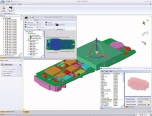 |
Electronics
New tools in the 2007+ release improve interaction with ECAD data from PCB designers. Built on the same core technology found in SolidWorks-integrated CircuitWorks, Priware (Shropshire, UK; priware. com) has developed a SpaceClaim add-on that handles the read and write of IDF (2.0, 3.0, 4.0) and Mentor PADS (*.asc) file formats. Boards can be previewed, components filtered and, when loaded, both the board and component models are automatically generated and stored within a self-populating intelligent parts library.
Modular System
SpaceClaim is priced on a yearly fee basis, something tried before with varying degrees of success. The application is free; you pay an annual maintenance fee, for which you get full access to software updates and support. For the base-level SpaceClaim Professional application, which includes IGES, STEP, VDA, DWG/DWF, and a Home edition for use at home, the cost is $1,700 per year.
If you want to sign up for three years, you get around a 15 percent discount on that rate. Then there are add-ons, again priced at a yearly rate. If you want the 3D data exchange package, which includes Parasolid, ACIS, CATIA V4, Pro/E, NX, Inventor, and SolidWorks — that costs $300. There are then application-specific translators for reading and writing CATIA V5 ($500), and JT ($300).
Other adds-on for ECAD and a standard parts library from TraceParts (Saint Romain, France; traceparts.com) are priced at $800 and $650, respectively. The Sheet metal package costs $500, which seems silly considering that every other vendor includes sheet metal as part of the core package; and this one’s not yet a fully functional add-on. For around $2,000, you get the functionality most people will need (the modeling tools and the 3D data exchange package) at a price comparable with many other mainstream applications. But when you look at those involved in the supply chain, perhaps where CATIA V5 or JT data is prevalent, then the cost savings is good compared with licensing the authoring applications.
One thing that worries me is the increasingly modular nature of the system. We’re still in the first or second release cycle and already there are six add-on modules, each priced separately. I would guess there are more coming (that’s small beans compared to CATIA), but it shows a trend toward charging the customer for every single new feature and function.
Next Big Thing
In any event, SpaceClaim is an impressive tool; of that there’s little doubt. The industry has become rather staid in terms of development and there’s been nothing totally new for some time. Perhaps it’s time for a shake-up.
If you listen to the marketing messages coming from SpaceClaim, you’d think that they don’t see the application as competing with the existing players in the market, instead they are trying to build the perception that SpaceClaim is intended to sit between other MCAD applications, providing data editing rather than raw modeling. It’s a good message, but probably one borne from the desire to slip in under the radar of the other vendors who, in this mature market, tend to reach for the checkbook when a potential threat comes along. Let’s hope SpaceClaim can build a business before it is acquired. It’s clear it is a fundamentally different way of working with geometry to develop new products.
If you’re looking at your MCAD system and wondering if there’s something else out there, I can tell you there is. Take a look — we might be seeing the next big thing.
More Information
SpaceClaim Professional 2007+
SpaceClaim Corporation
Concord, MA
spaceclaim.com
Al Dean is technology editor at MCAD Magazine, a UK product development and manufacturing technology journal (mcadonline.com) and is editor of Prototype magazine (prototypemagazine.com). You can send comments about this article to DE-Editorsmailto:[email protected].
Subscribe to our FREE magazine, FREE email newsletters or both!
Latest News
About the Author
DE’s editors contribute news and new product announcements to Digital Engineering.
Press releases may be sent to them via [email protected].






